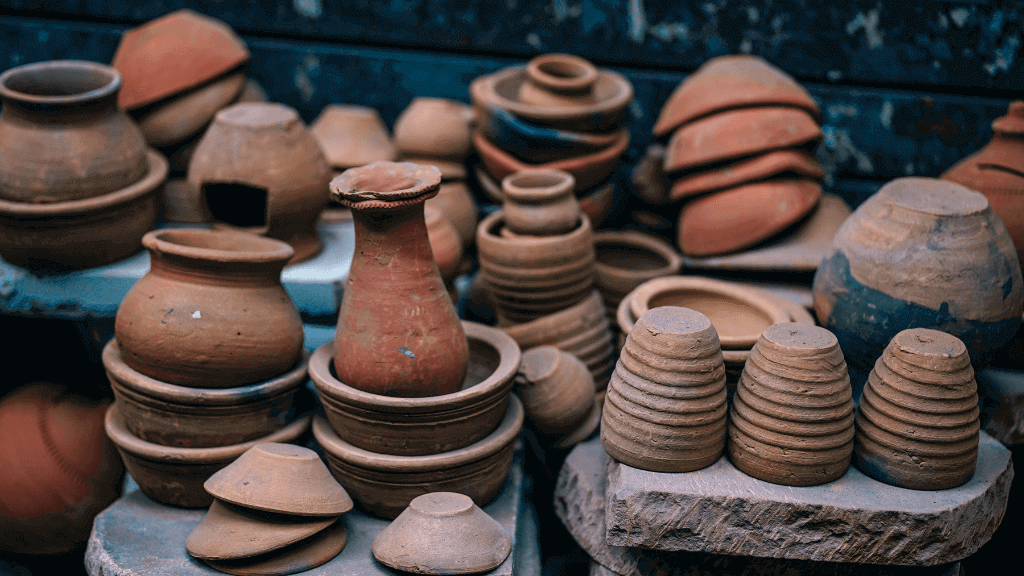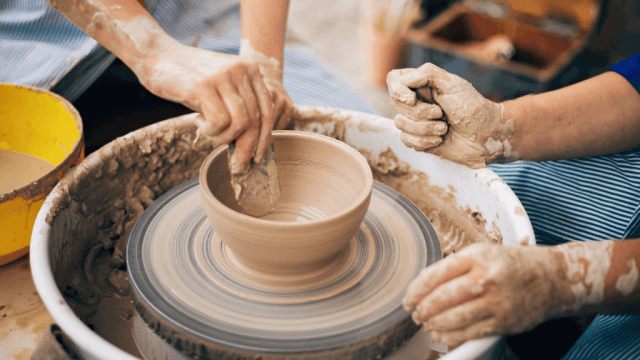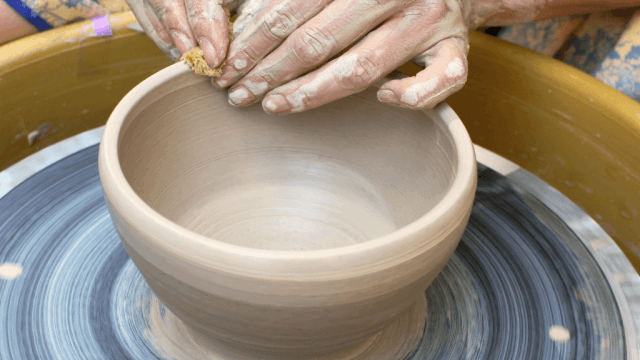A person who makes pottery is called a potter. Ceramic artists are also called potters, and those specializing in making ceramic products or works of art are known as ceramists.
While potter is the most commonly used term, other related terms exist, such as ceramist or ceramic artist. A ceramist works with ceramic materials, which include pottery, but can also extend to other objects made from clay.
The Process of Making Pottery. What do you call someone who makes pottery? A person who makes pottery.
One of the key tasks a potter undertakes is the pottery-making process. This involves a series of steps: choosing the right clay, shaping it into the desired form, and then firing it in a kiln to harden and finish the piece.
What do potters do?
Potters are skilled artisans who create pottery. This includes vases, bowls, plates, and other items made from clay. They use various techniques to shape and decorate the pottery before firing it in a kiln.
How does someone become a potter?
Many potters learn their craft through art school or a ceramics program, but learning through apprenticeships or self-study is possible.
Learn more about how to get into pottery
What is the history of pottery making?
Pottery making has a rich history dating back to the Neolithic period around 10,000 B.C. Different cultures have unique pottery traditions, like the Jomon pottery of Japan, known for its intricate cord markings, and the painted earthenware of ancient Greece.
What are the different types of pottery?
There are three main types of pottery: earthenware, stoneware, and porcelain.
- Earthenware is porous and typically used for everyday dishware; it’s fired at lower temperatures.
- Stoneware is non-porous and more durable, ideal for cookware and kitchenware.
- Porcelain is made from fine white clay, and is fired at high temperatures, resulting in a translucent finish often seen in fine china.
Expanded Types of Pottery: Specialized Forms and Techniques
Pottery is an expansive field with various types, styles, and techniques, each offering unique aesthetic and functional qualities. Alongside main categories like earthenware, stoneware, and porcelain, numerous specialized forms exist:
Earthenware
- Terracotta: Known for its orange-brown color, it is often used for plant pots.
- Majolica: Coated with opaque white glaze and often painted with colorful designs.
- Faience: Features a tin-glazed surface, typically with intricate painted designs.
- Redware: A subtype of earthenware, it has a red hue due to the iron content in the clay.
- Delft: A form of tin-glazed earthenware originally made in the Netherlands, often blue and white.
- Talavera: A Mexican and Spanish pottery tradition with intricate, colorful designs.
- Slipware: Earthenware decorated using liquid clay, or “slip,” applied before firing.
Stoneware
- Ironstone: Exceptionally durable and often used for dinnerware.
- Cane Ware: Light-colored, often used for baking dishes.
- Salt-Glaze: Stoneware with a glass-like glaze formed by throwing salt into the kiln during firing.
Porcelain
- Bone China: Includes bone ash, making it exceptionally strong and translucent.
- Hard-Paste Porcelain: Composed mainly of kaolin and feldspar.
- Soft-Paste Porcelain: Less durable than hard-paste, typically fired at lower temperatures.
- Lusterware: Features metallic glazes that give the surface a shimmering finish.
- Celadon: A type of glazed porcelain with a jade-green hue.
- Satsuma: A form of Japanese porcelain often embellished with gold.
Other Specialized Types
- Pinch Pottery: A technique rather than a type, where clay is shaped by pinching it between the thumb and fingers.
- Glazed Pottery: Refers to any pottery that has been treated with a glass-like surface coating.
- Blackware: Known for its deep, black sheen.
- Raku: A Japanese pottery type with unpredictable results from a unique low-temperature firing process.
What are the most common techniques used in pottery making?
Common pottery-making techniques include:
- Wheel throwing – shaping the clay on a rotating wheel
- Coiling – building up the walls of a pot with coils of clay
- Slabbing – using flat slabs of clay to construct a piece
- Molding – shaping clay within a rigid or semi-rigid frame or mold
Each technique imparts unique shapes and textures to the pottery.
What are the essential tools for pottery making?
Essential pottery tools include:
- Pottery Wheel – for shaping the clay into round forms
- Kiln – for firing and hardening the pottery
- Various Clays – for achieving different textures and forms
- Glazes – for achieving different textures and colors
- Ribs – for smoothing the surface of the clay
- Needles – for detailing and piercing
- Scrapers – for shaping and finishing
- Loop and Ribbon Tools – for carving and hollowing
- Brushes – for applying glaze or slip
- Sponges – for smoothing and wetting the clay
- Calipers – for measuring the dimensions of the pottery
- Slab Roller – for creating even, flat slabs of clay
- Wire Cutter – for slicing through clay or removing pottery from the wheel
- Modeling Tools – for sculpting and adding finer details
Each tool serves a specific purpose and facilitates different aspects of the pottery-making process.
What is the difference between a potter, a ceramist, and a ceramic artist?
- Potter – Refers to someone who primarily makes functional pottery items, like bowls, plates, and vases.
- Ceramist – Works with ceramics in a broader sense, including pottery as well as other clay objects, which could be functional or decorative.
- Ceramic Artist – Often refers to someone who focuses on creating ceramic art, which may or may not be functional. The emphasis is generally on aesthetics and artistic expression.
These definitions provide a general guideline, but meanings can vary by region and context.
What are some famous potters or pieces of pottery?
Famous Potters:
-
Bernard Leach – Known for fusing Western and Eastern pottery traditions, Leach profoundly influenced 20th-century ceramics.
-
Lucie Rie – Renowned for her modernist works, Rie’s pottery often features simple, elegant forms and focuses on texture and color.
Famous Pottery Pieces:
-
Chinese Terracotta Army – A collection of life-sized terracotta statues buried with the first Emperor of China, Qin Shi Huang, to accompany him in the afterlife.
-
Greek Amphora Vases – Known for their distinctive shape and intricately painted scenes, they often depicted mythological stories or historical events.
Additional Entries:
-
Beatrice Wood – Known as the “Mama of Dada,” Wood’s ceramics are characterized by lustrous glazes and whimsical forms.
-
Hamada Shoji – A Japanese potter who was a significant figure in the Mingei (folk art) movement, emphasizing the importance of traditional techniques and materials.
-
Maria Martinez – A Native American potter known for her polished black pottery, reviving Pueblo pottery traditions.
-
Ishtar Gate Dragons – Part of the Ishtar Gate from ancient Babylon are ceramic reliefs of dragons that show craftsmanship in the Mesopotamian era.
-
Jomon Pottery – Among the oldest known pottery pieces in the world, these come from the Jomon period in ancient Japan and are characterized by their intricate cord-marked patterns.
Each potter and pottery piece holds significant historical, artistic, or cultural value.
Can pottery making be a career?
Pottery making can indeed be a career. Potters sell their work through various channels like galleries, craft fairs, or online platforms. Many also teach pottery classes. However, like any artistic career, it’s often challenging and may require supplemental income sources, particularly when starting out.
Discover more about making money selling pottery
How can I start learning pottery?
To start learning pottery, consider enrolling in local pottery classes or joining workshops at community centers or art schools. Online platforms like MasterClass or Udemy also offer pottery courses. You’ll need access to basic pottery tools like clay, a pottery wheel, and a kiln. Always check reviews or ask for recommendations when choosing a class or workshop.
What Are Some Common Techniques Used By Potters To Shape Clay Into Pottery?
Common techniques used by potters to shape clay into pottery include slab construction, coiling, pinching, sgraffito, raku and the pinch pot technique.
- Slab construction involves rolling out clay with a slab roller or rolling pin and then cutting it into desired shapes.
- Coiling involves rolling out long strips of clay and then stacking them on top of each other to form a desired shape.
- Pinching involves using the fingers to shape the clay into a desired form.
- Sgraffito is a technique where designs are scratched onto the surface of the clay before firing.
- Raku is a type of firing process that produces unique effects on the surface of the clay.
- The pinch pot technique is one of the oldest known ways of making ceramics and involves shaping a single ball of clay with your hands.
The Historical Significance Of Pottery-Making In Different Cultures Around The World.
Pottery has been an important part of many cultures around the world for centuries.
It has been used to determine chronology, ethnicity, trade, prestige, and building materials in archaeological studies.
Pottery can also be dated based on stratigraphic sequences, and ancient pottery cultures have shaped what we cherish today in the art world.
The ancient Egyptians are credited with creating the first kilns to heat pottery, while the Greeks were credited with making pottery an art form.
How Has Modern Technology Impacted The Traditional Art Of Pottery-Making?
Modern technology has had a significant impact on the traditional art of pottery-making.
Advanced ceramic production techniques, such as casting for mass production, have been introduced, while digital representation of Xiaopi Kiln Ceramic Art has become a new development trend.
Despite this, traditional pottery-making is still alive and well, with many resources available to help those interested in getting started.
What Challenges Do Potters Face When Creating Large-Scale Pieces Or Collaborating On A Project With Other Artists?
Potters face a variety of challenges when creating large-scale pieces or collaborating on a project with other artists.
These include the complexity of the process, the need to work with different materials and techniques, and the difficulty of coordinating multiple people’s efforts.
Additionally, large-scale artworks require more resources and time to create than smaller works, and it can be difficult to find other artists who are willing to collaborate.
What Common Types Of Pottery Are Made For Functional Purposes Versus Decorative Purposes?
Common types of pottery made for functional purposes include earthenware, stoneware, porcelain, and bone china.
- Earthenware is a porous low-fired clay with relatively low physical hardness.
- Stoneware is a popular type of clay for making dinnerware and mugs due to its durability.
- Porcelain is a hard, white clay that is fired at high temperatures.
- Bone china is a type of porcelain made with bone ash that is translucent when held up to the light.
Where Do Potters Source Materials and Tools?
Potters commonly source their clay, glazes, and tools from specialized ceramic supply stores. Online platforms are also an avenue for finding quality materials. The choice of clay and glazes often depends on the specific project and the desired finish.
Global Pottery Styles: From Japanese Raku to Native American Earthenware
Pottery styles vary greatly around the world. Japanese Raku is known for its unique firing process and unpredictable results. Korean Celadon is celebrated for its delicate greenish glazes. Native American pottery often features earthen tones and intricate hand-painted designs. Each style reflects its cultural roots and aesthetic preferences.
Health Benefits: Why Pottery Making is Good for You
The act of creating pottery offers several health benefits. It is a form of stress relief, providing a mental break from daily pressures. Pottery-making also enhances focus and hand-eye coordination. The repetitive motions involved in shaping clay can be meditative, promoting a sense of well-being.
A Guide to Pottery Firing Techniques
Various firing techniques produce distinct outcomes. Electric kilns are easy to control but may lack the “character” of other methods. Wood-fired kilns add unique ash and flame patterns. Salt/soda firing introduces volatile elements into the kiln, affecting the glaze and clay body. Each technique offers a different artistic expression.
Making Pottery a Business: How to Sell Your Creations
Turning pottery into a business involves more than just creating beautiful pieces. Potters market their work through social media, craft fairs, and galleries. Pricing considers the cost of materials, time invested, and the piece’s perceived value. Online platforms like Etsy also offer a marketplace for pottery.
Pottery in Pop Culture: The Clay’s Big Screen Moments
Pottery has made notable appearances in pop culture. Movies like “Ghost” have romanticized the art form, while TV shows often feature potters and ceramic artists in plotlines. These depictions increase public interest and add a touch of glamour to the craft.
Caring for Your Pottery: Tips on Maintenance
Different types of pottery require specific care. Earthenware should be handled gently and is generally not dishwasher-safe. Stoneware and porcelain are more durable and often dishwasher-safe, but always read the maker’s guidelines. Cracks and chips can sometimes be repaired, but consult a professional for valuable pieces.











